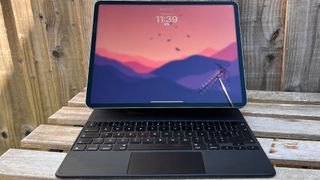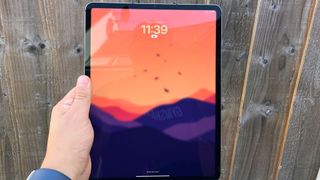Live Science Verdict
The iPad Pro 12.9-inch with M1 is the most expensive Apple tablet, but it’s a tough value proposition that’s wedged between the 2022 iPad Pro and a MacBook.
Pros
- +
Great display
- +
Laptop level performance
- +
Modular design is great…
Cons
- -
Keyboard is pricey
- -
Expensive
- -
iPadOS still feels undercooked
Why you can trust Live Science
Price: $1,099.00/£999
Screen size: 12.9-inch
Weight: 1.5 lbs (680 g)
Memory: 8 GB as standard, 16 GB on higher capacity options
Battery life: Up to 10 hours wireless web browsing
Storage: 128 GB, 256 GB, 512 GB, 1 TB, or 2 TB versions
Warranty: 1 year, extendable with AppleCare
Operating system: iPadOS 15 (iPadOS 16 compatible)
Display: Liquid Retina XDR display with mini-LED backlighting and 2732 x 2048 resolution
CPU: Apple M1 chip (8-core CPU, 8-core GPU, 16-core Neural Engine)
Graphics: M1 includes 8-core GPU
Ports: Thunderbolt/USB 4 port
While tablets might not be the go-to device for most students, they do offer a highly portable alternative to laptops, and iPads are the king of the tablet world. Amongst them, the iPad Pro is the top-end model so we thought we'd take the most recent version, the iPad Pro 12.9" M1, out for a spin.
The iPad Pro is a tough sell at first glance, when the cheaper iPad, and even the iPad Mini exist. These are even more portable and a lot more affordable, even if they lack the power of their big brother.
Complicating things further is the iPad Air – the favorite son that can seemingly do no wrong. It’s got the same processor as the iPad Pro (the M1 found in Apple’s laptop lineup), but at the base end it costs $500 less.
We’re specifically reviewing the iPad Pro 12.9-inch model here. There is an iPad Pro 11-inch, which, apart from the obvious size difference and a slightly dimmer screen, is identical in terms of tech specs. So, if you like the sound of this but want a smaller, cheaper model, then check out the 11 inch version.
But is the iPad Pro worth checking out at all? Thankfully, the answer is yes. This powerhouse tablet is one of the best tablets for students who need that portability of a tablet with the power of a laptop.
iPad Pro M1 review: Set up and usability
If you’ve set up an iPad or iPhone in the last few years, you’ll have an idea of what to expect – turn the iPad Pro on and it’ll immediately begin the process of logging into your Apple ID, setting up FaceID, and asking whether you want to import your settings from another tablet.
It takes mere minutes and, before you know it, you’re on the home screen with any apps you’ve carried over.
iPad Pro M1 review: Design, specs, and features

The iPad has long been envisaged as a slate of glass that can do anything, and the iPad Pro still feels like the clearest distillation of that premise. The design hasn’t actually changed since 2020, at least on the outside, but it still looks great in both Silver and Space Gray.
Part of that is down to just how huge the screen feels, with thinner bezels than seemed possible back when the first iPad Pro debuted. There’s a 12 MP camera embedded in the ‘top’ edge (when held portrait), and FaceTime works in both portrait and landscape orientations.
On the back, there’s a 12 MP camera, and a 10 MP Ultra Wide option. If you’ve not got an iPhone camera and are happy holding this one aloft, it can take some great pictures.



On one side you’ll find a volume rocker and a spot to magnetically attach an Apple Pencil (more on accessories shortly), but the only port to be found here is a USB-C one at the ‘bottom’ (again, speaking in portrait terms). This is used for both data and charging, so if you’re looking to plug multiple things in, you’ll need a dongle.
Returning to the display, it’s hard to overstate just how impressive it is, even if you owned the prior, almost identical 12.9-inch iPad Pro. That’s because there’s mini-LED backlighting underneath the display, meaning there is some truly incredible contrast on display (1,000,000:1 in fact), and it gets very bright, too, with up to 1,600 nits when watching HDR content. It’s the kind of display that truly pops with the right content, such as the latest season of Stranger Things or Andor.
There are also four speakers subtly placed in each corner which provide truly impressive output for a device with such a slim chassis.
iPad Pro M1 review: Features and performance
The iPad Pro’s M1 chip means it has the same chip as Apple’s laptop line-up. At its most basic level, that means that it’s the most capable, powerful tablet around.
Whether you’re playing games on it, running multiple apps in multitasking, or getting creative with the Apple Pencil, the iPad Pro 12.9-inch simply won’t break a sweat – and the 10-11 hours of battery life on a device this svelte is pretty incredible and also a testament to the M1’s power efficiency.
If you’re looking for something just for web browsing, writing up notes, or sending emails, it’s likely to be overkill, but Apple has yet to fully embrace the iPad Pro as a professional machine. For example, the company’s powerful creation tools, like Final Cut Pro and Logic Pro, still don’t exist on the device.
iPadOS also still feels like it’s stuck in iOS’ shadow, too, while also making professionals look enviously to Mac laptops. In many ways, despite getting its own name a couple of years ago, iPadOS makes the iPad a big iPhone. However, while multitasking is solid enough, it still never feels quite as fluid as it can on a Mac.

That’s something that Apple is looking to counterbalance somewhat with iPadOS 16 (the next version). This actually adds features that are specific to iPads with the M1 chip, such as Stage Manager, for more versatile multitasking support, as well as finally improving external display support so that images aren’t simply mirrored.
It’s a big step, and combined with the Magic Keyboard the iPad Pro is now closer than ever to being a laptop replacement – although there’s still some way to go. The keyboard itself also costs $349 for the 12.9-inch iPad, making it a very expensive way to type, although it is remarkably well designed.
Finally, there’s the Apple Pencil. Digital artists will no doubt love the freedom of being able to create masterpieces on the go, while note-takers will be able to enjoy scribbling things down when the mood strikes. And yet, that’s another $129.
iPad Pro M1 review: Price
We’ve been constantly referring back to the price of the iPad Pro throughout this review. That’s as much to highlight the alternatives as it is to point out what a high cost it is, with prices for the iPad Pro 12.9 starting at $1,099 with 128 GB of storage. You can get the 11-inch iPad Pro for a much more palatable $799.
Considering an iPad Pro with the Magic Keyboard can cost around $1,500, you could pick up the all-new MacBook Air M2 for around $300 less and arguably get a more capable machine because of macOS’ flexibility.
If you do definitely want to get a tablet, then the iPad Air that also has the M1 comes in at $599. That gets you a smaller, less dazzling display and no FaceID (and a basic 64 GB of storage), but it’s tough to point to any one feature on the iPad Pro 12.9-inch that feels like you’d pay half a grand for.
Working on the go and Wi-Fi not available? There’s also a version of the iPad Pro that adds cellular connectivity with 5G speeds that starts at $1,299.
iPad Pro M1 review: User reviews

Amazon reviewers are particularly pleased with the iPad Pro M1, with particular praise for the display and the responsiveness of the touch screen.
Others have noted how cinematic the movie-watching experience is with the display working in conjunction with the powerful speakers. It currently sits at a rather impressive 4.8 out of 5 stars overall from 5,250 ratings (at the time of writing).
Should you buy the iPad Pro M1?
If you’re looking for an iPad for taking notes, web surfing, social media, and streaming movies, there’s a good chance that the iPad Pro M1 simply isn’t for you. It’s an incredible piece of hardware, sure, but if you don’t take advantage of all that it offers it’d be like buying a Ferrari without having a driver’s license.
But if you do need a powerful tablet and aren't concerned with missing apps like Final Cut Pro and Logic Pro, there’s nothing better – it really is the best tablet in the world. The question you need to ask is, do you need the best tablet in the world when cheaper options will do for most people?
If this product isn’t for you
As we’ve mentioned a few times, it’s hard to count out the iPad Air for the significantly lower price, even with some minor corners cut.
Similarly, if you want to buy a more versatile device, the new MacBook Air M2 is a great option. It offers a great display, more powers, a built-in keyboard, and Apple’s latest processor which is very power efficient. Or if you’re looking for a slightly cheaper option, there’s also the MacBook Air M1 to consider.
Lloyd Coombes freelance tech and fitness writer for Live Science. He's an expert in all things Apple as well as in computer and gaming tech, with previous works published on TopTenReviews, Space.com, Dexerto and TechRadar. You'll find him regularly testing the latest MacBook or iPhone, but he spends most of his time writing about video games as Editor in Chief at GGRecon.com. He also covers board games and virtual reality, just to round out the nerdy pursuits.

